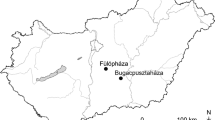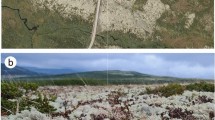Summary
Pseudocyphellaria dissimilis, a foliose, cyanobacterial lichen, is shown not to fit into the normal ecological concept of lichens. This species is both extremely shade-tolerant and also more intolerant to drying than aquatic lichens previously thought to be the most desiccation-sensitive of lichens. Samples of P. dissimilis from a humid rain-forest site in New Zealand were transported in a moist state to Germany. Photosynthesis response curves were generated. The effect of desiccation was measured by comparing CO2 exchange before and after a standard 20-h drying routine. Lichen thalli could be equilibrated at 15° C to relative humidities (RH) from 5% to almost 100%. Photosynthesis was saturated at a photosynthetically active radiation (PAR) level of 20 μmol m-2 s-1 (350 μbar CO2) and PAR compensation was a very low 1 μmol m-2 s-1. Photosynthesis did not saturate until 1500 μbar CO2. Net photosynthesis was relatively unaffected by temperature between 10° C and 30° C with upper compensation at over 40° C. Temporary depression of photosynthesis occurred after a drying period of 20 h with equilibration at 45–65% relative humidity (RH). Sustained damage occurred at 15–25% RH and many samples died after equilibration at 5–16% RH. Microclimate studies of the lichen habitat below the evergreen, broadleaf forest canopy revealed consistently low PAR (normally below 10–20 μmol m-2 s-1) and high humidities (over 80% RH even during the day time). The species shows many features of an extremely deep shade-adapted plant including low PAR saturation and compensation, low photosynthetic and respiratory rates and low dry weight per unit area.
Similar content being viewed by others
References
Björkmann, O, Demmig B (1987) Photon yield of CO2 evolution and chlorophyll fluorescence characteristics at 77K among vascular plants of diverse origins. Planta 170:489–504
Björkman O, Ludlow MM, Morrow PA (1972) Photosynthetic performance of two rainforest species in their native habitat and analysis of their gas exchange. Carnegie Inst Washington Yearb 71:94–102
Boardman NK (1977) Comparative photosynthesis of sun and shade plants. Ann Rev Plant Physiol 28:355–371
Brown DH, Snelgar WP, Green TGA (1981) Effects of storage conditions on lichen respiration and desiccation sensitivity. Ann Bot 48:923–926
Demmig-Adams B, Maguas C, Adams III WW, Meyer A, Kilian E, Lange OL (1990) Effect of high light on the efficiency of photochemical energy conversion in a variety of lichen species with green and blue-green phycobionts. Planta 180:400–409
Ehleringer J, Pearcy RW (1983) Variation in quantum yield for CO2 uptake among C3 and C4 plants. Plant Physiol 73:555–559
Galloway DJ (1985) Flora of New Zealand: Lichens. Government Printer, Wellington
Green TGA (1982) Photosynthesis of Antarctic bryophytes; field studies in the McMurdo Dry Valley region. XIIIth International Botanical Congress, Abstracts p 290
Green TGA, Snelgar WP (1982) A comparison of photosynthesis in two thalloid liverworts. Oecologia 54:275–280
Green TGA, Snelgar WP, Wilkins AL (1985) Photosynthesis, water relations and thallus morphology in the Stictaceae. In: Brown DH (ed) Lichen Physiology. Plenum Press, New York, pp 57–75
Kappen L (1988) Ecophysiological relationships in different climatic regions. In: Galun M (ed) Handbook of Lichenology, Vol. II. CRC Press, Boka Rota, pp 37–100
Kershaw KA (1985) Physiological Ecology of Lichens. Cambridge University Press, Cambridge
Kirschbaum MUF, Pearcy RW (1988) Concurrent measurements of oxygen and carbon dioxide exchange during light flecks in Alocasia macrorrhiza (L.) G. Don. Planta 174:528–533
Lange OL, Redon J (1983) Epiphytische Flechten im Bereich einer chilenischen “Nebeloase” (Fray Jorge). II. Ökophysiologische Charakterisierung von CO2 Gaswechsel und Wasserhaushalt. Flora 174:245–284
Lange OL, Kilian E, Ziegler H (1986) Water vapour uptake and photosynthesis of lichens: performance differences in species with green and blue-green algae as phycobionts. Oecologia 71:104–110
Lange OL, Tenhunen JD (1981) Moisture content and CO2 exchange of lichens. II. Depression of net photosynthesis in Ramalina maciformis at high water content is caused by increased thallus carbon dioxide diffusion resistance. Oecologia 51:426–429
Proctor MCF (1979) Structure and eco-physiological adaptation in bryophytes. In: Clarke GGS, Duckett JG (eds) Bryophyte Systematics. Academic Press, London New York, pp 429–509
Ried A (1960) Stoffwechsel und Verbreitungsgrenzen von Flechten. II. Wasser- und Assimilationshaushalt, Entquellungs- und Submersionsresistenz von Krustenflechten benachbarter Standorte. Flora 149:345–85
Snelgar WP (1981) The ecophysiology of New Zealand forest lichens with special reference to carbon dioxide exchange. D. Phil. thesis, University of Waikato
Snelgar WP, Green TGA (1981) Ecologically-linked variation in morphology, acetylene reduction and water relations in Pseudocyphellaria dissimilis. New Phytol 76:403–411
Snelgar WP, Brown DH, Green TGA (1980) A provisional survey of the interaction between net photosynthetic rate, respiratory rate, and thallus water content in some New Zealand cryptogams. NZ J Bot 18:247–256
Snelgar WP, Green TGA, Wilkins AL (1981) Carbon dioxide exchange in lichens: resistances to CO2 uptake at different thallus water contents. New Phytol 88:353–361
Author information
Authors and Affiliations
Rights and permissions
About this article
Cite this article
Green, T.G.A., Kilian, E. & Lange, O.L. Pseudocyphellaria dissimilis: a desiccation-sensitive, highly shade-adapted lichen from New Zealand. Oecologia 85, 498–503 (1991). https://doi.org/10.1007/BF00323761
Received:
Accepted:
Issue Date:
DOI: https://doi.org/10.1007/BF00323761




